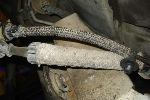If you were planning on doing some AC work, there are few special tools that you’ll need. The recovery systems are usually cost prohibitive for most home DIY guys. As a plan of action, you could have the AC Shop test for leaks and/or recover the refrigerant from your system. Then, you could do the replacement of parts (if any) and recharge the system by yourself.
BTW….the links that I have provided here, are just to help you visualize the part ..you can buy from whomever, you want to.
For AC parts and tools, you could check with major AC Supply Houses like:
http://www.ackits.com/
http://www.acsource.com/
But, I’ve found some pretty good deals at my local Harbor Freight store. If you don’t have one close by, you could always mail order. Watch for their frequent sales. Hint: If there is a catalog (internet) sale, the local store will honor the sale price. Just print the page and take it into the store.
http://www.harborfreightusa.com/usa/common/start.do
The dual gauge manifold set is needed for any serious DIY AC work.
Manifold set - at the Harbor Freight site enter part#92649
Vacuum pump (evacuator):
Some folks have used a venturi style evacuator with success. Though, you will need a decent shop compressor to use it (one person commented that he used his with a 30 gallon Craftsmen 6 hp compressor). It works. Just not as easy to use as an electric evacuator pump.
venturi style evacuation - at the Harbor Freight site enter part#92475
The elec. vacuum pumps are available from various mfns at different levels of suction power and prices. Ebay has a lot of them at very good prices. I got one for home use that is factory rated to suck down to the 50 micron level (paid about $125). Anything that will suck down to lower than 200 microns should be good enough.
Elec. Vacuum Pump -
http://www.napaonline.com/masterpag...PartNumber=781900&Description=A/C+Vacuum+Pump
***A Manifold Set and Vacuum Pump can usually be purchased as a kit (cheaper than the single prices).
__________________________________________________________________________________________________________________________________
Smaller Tools:
You will still need the can tap connector that will be used to tap the sealed R-134a can and connect it to the yellow hose.
AC Can Tap -
http://www.napaonline.com/masterpag...er=783012&Description=A/C+Refrigerant+Can+Tap
You’ll likely need a quick detach tool to get those AC lines open and/or disconnected. They can also be used for fuel lines.
quick detach tool -
http://www.napaonline.com/masterpag...cription=A/C+&+Fuel+Line+Quick+Disconnect+Set
Also handy to remove the orifice tube….though, I’ve used a long nose pliers.
Orifice Removal Tool -
http://www.napaonline.com/masterpag...er=783205&Description=A/C+Orifice+Tube+Puller
If you want to look for leaks yourself, here is a tool that retails at almost $100.
Leak detector - at the Harbor Freight site enter part#92514










